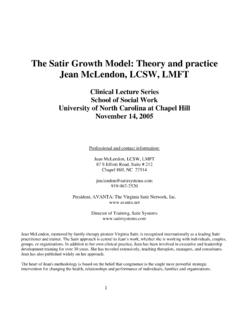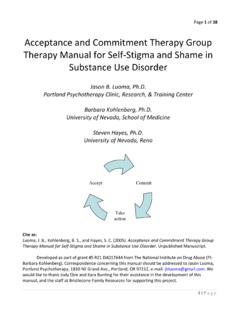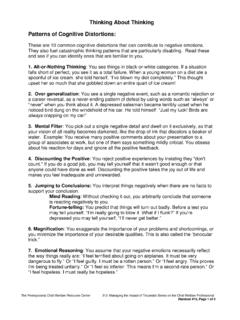Transcription of Hidden No More: Moving from Shame to Whole-Hearted …
1 Workshop on Shame and Whole Hearted Living, with Kate Thieda2/22/2016 UNC School of Social Work Clinical Lecture Series1 Hidden No more : Moving from Shame to WholeheartedLivingKate Thieda, MS, LPC, 22, 2016 UNC School of Social Work Clinical Lecture SeriesHello! Glad You re Here!What are we going to talk about today? Shame : definitions, how Shame shows up in the clinical setting, and teaching Shame resilience, empathy, and self-compassion Wholehearted living: what it is, what gets in the way, and the 10 GuidepostsBren Brown and Shame Research Research professor at the University of Houston Graduate School of Social Work Published I Thought It Was Just Me, But It Isn tin 2007 First became widely known after her TEDxHouston talk in 2010, The Power of Vulnerability , went viral Published The Gifts of Imperfectionin 2010 Connections curriculum Published Daring Greatlyin 2012 The Daring Way curriculum Published Rising Strongin 2015 Rising Strongcurriculum COURAGE worksonline curriculum in 2016 What is Shame ?
2 Shame is the intensely painful feeling or experience of believing we are flawed and therefore unworthy of love and , Shame , Go Away Everyone has it it is our most primitive human affect. No one wants to talk about it. The less we talk about it, the more we have it. If you don t do Shame , Shame will do you. Shame hates words wrapped around Shame GrowsShame is a social concept. Shame happens between people and heals between needs three things to grow exponentially: Secrecy Silence JudgmentWorkshop on Shame and Whole Hearted Living, with Kate Thieda2/22/2016 UNC School of Social Work Clinical Lecture Series2 Definitions Shame : I am bad. Focus on self, not behavior, with the result that we feel alone. Shame is never known to lead us toward positive change. Guilt: I did something bad.
3 Focus on behavior. Guilt has the potential to motivate us toward positive change. Embarrassment: fleeting, sometimes funny. I know I am not alone -it could have happened to someone else. Humiliation: the variable that differentiates humiliation is: Did I deserve this? Shame in the Clinical Office Depression Anxiety Eating disorders Infidelity Addiction Appearance / body image Money Work Family Parenting Sex Aging Religion Surviving trauma Clues to Shame in the Room Negative tapes or gremlins Keeping secrets -from you, from others Doing the same negative behavior repeatedly Avoiding or minimizing a topic that causes pain People-pleasing Aggression, anger Women and ShameShame when you are anything less than perfect being judged by other mothers being exposed never good enough when you can t pull off looking like it is all under control never enough having no seat at the cool table Men and ShameShame failure being wrong a sense of being defective when people think you are soft revealing a weakness showing fear being seen as the guy you can shove up against the lockers being criticized or ridiculedYou try it Shame on Shame and Whole Hearted Living, with Kate Thieda2/22/2016 UNC School of Social Work Clinical Lecture Series3I get it, Shame is bad.
4 Now, what do I do to help clients deal with it? Awareness Shame resilience Empathy Self-compassionShame Resilience Shame resilience is the ability practice authenticity when experiencing Shame move through the experience without sacrificing our values come out the other side with more courage, compassion, and connection than we had going into itShame resistance is not possible -it will only further the disconnection between people and encourage Shame to Clients Shame ResilienceThree steps to becoming Shame resilient: Recognizing Shame and understanding its triggers Practicing critical awareness Reaching out and speaking shameStep 1: Recognizing Shame and Understanding Its Triggers Shame is biology and biography. Learning to physically recognize when you are in the grips of Shame , feel your way through it, and figure out what messages and expectations triggered itQuestions to Ask Clients What does Shame mean to you?
5 What are some of your physical symptoms that let you know you are experiencing Shame ? When you feel Shame , do you: Go quiet and disappear? ( Moving away) Do whatever the other person wants in order to make the Shame stop or disappear? ( Moving towards) Go on the attack, trying to make someone else feel bad? ( Moving against)Step 2: Practicing Critical Awareness Reality-checking the messages and expectations that are driving Shame Are the messages what YOU want to be or what you think OTHERS want/need from you?Workshop on Shame and Whole Hearted Living, with Kate Thieda2/22/2016 UNC School of Social Work Clinical Lecture Series4 Questions to Ask Clients What were the messages you got as a child from loved ones or people who were important to you? When you hear a gremlin in your head, are you hearing someone else s voice?
6 Who? Why? Ideal identities: I want to be seen as _____ Unwanted identities: I do not want to be seen as _____Step 3:Reaching Out and Speaking Shame Owning and sharing your story Connection is critical (and often difficult for clients) Asking for what you needQuestions to Ask Clients Does anyone else know your story? Who is someone safe with whom you can share your story? How do you know this is a safe person? When might be a good opportunity to talk to this person to share your story? If there isn t anyone you can talk to, how might you connect with others who have had similar experiences? What do you need from others right now? Who is capable of giving that to you? Shame and Empathy Shame results in fear, blame (of self or others), and disconnection. Empathy is the most powerful antidote to Shame .
7 Clients need to understand the difference between empathy and sympathy because empathy heals Shame while sympathy reinforces out of emotions in other peopleand , or feeling with peopleTheresa WisemanSelf-Compassion Kristin Neff, PhD is an associate professorhuman development and cultureat the University of Texas at Austin, and a leading researcher on self-compassion. We are generally fine with giving compassion to others, but typically not so good in being compassionate towards on Shame and Whole Hearted Living, with Kate Thieda2/22/2016 UNC School of Social Work Clinical Lecture Series5 Three Elements of Self-Compassion Self-kindness Common humanity MindfulnessSelf-KindnessBeing warm and understanding toward ourselves when we suffer, fail, or feel inadequate, rather than ignoring our pain or flagellating ourselves with self-criticism.
8 I just need to try harder. I should have known better. I've always been this way and/or I am never going to change. Teaching Self-Kindness to Clients Soothing ourselves taps into our mammalian caregiving system and triggers the release of oxytocin more than just stopping critical thoughts, self-kindness requires actively comforting ourselves, as we would a loved one who is in pain Use kind words Give yourself a hug, tenderly stroke your arms or face, or imagine giving yourself a hugCommon HumanityRecognizing that suffering and personal inadequacy is part of the shared human experience something that we all go through rather than being something that happens to me alone. Everyone else seems to get it done. None of the other moms have problems like this. I ve failed at being an adult.
9 Teaching Clients about Common Humanity Help clients remember that all humans make mistakes, have challenges in life, and suffer Help clients identify the ways in which their experience was connected to the larger human experience, such as acknowledging that being human means being imperfect Have clients think about the various causes and conditions underlying the painful eventMindfulnessTaking a balanced approach to our negative emotions so that feelings are neither suppressed nor exaggerated. We cannot ignore our pain and feel compassion for it at the same time. Mindfulness requires that we not be over-identified with thoughts and feelings, so that we are caught up and swept away by negative reactivity. I m always going to feel this way. I can t think about this I ll get so _____, I ll never recover.
10 It is not okay to feel _____. Workshop on Shame and Whole Hearted Living, with Kate Thieda2/22/2016 UNC School of Social Work Clinical Lecture Series6 Teaching Clients About Mindfulness (in the context of Self-Compassion) Help clients be awareof their feelings as opposed to becomingtheir feelings Suffering = Pain x Resistance Encourage regular mindfulness practice when they are not experiencing pain What Self-Compassion is Not It is not self-pity It is not self-indulgence It is not self-esteemSelf-Compassion MantraThis is a moment of is a part of I be kind to myself in this I give myself the compassion I vs. Wholehearted LivingPause for a Reality-Check These are ideals. Every human on this planet has unique biology and biography. Clients may not have the resources (defined in many ways) to achieve wholeheartedness, but pieces of the following may be Culture Daily messages: Shame , comparison, disengagement Using weapons and armor Making choices that are not aligned with values Experiences of Shame lead to deeper fear, blame, disconnectionWholehearted Living Daily practices: courage, compassion, connection Putting down the weapons and armor Aligning with values Shame is still painful and challenges our sense of worthiness, but can also lead to deeper self-compassion, empathy, and on Shame and Whole Hearted Living, with Kate Thieda2/22/2016 UNC School of Social Work Clinical Lecture Series7 Tenets of Wholehearted Living.

















